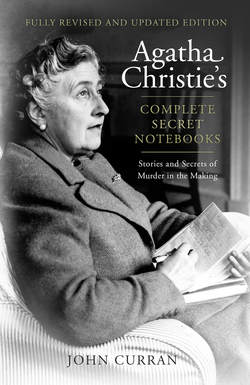Читать книгу Agatha Christie’s Complete Secret Notebooks - Агата Кристи, Agatha Christie, Detection Club The - Страница 67
The comparison of cigarette butts
Оглавление‘Murder in the Mews’ features not just this idea but also the clue of the cigarette smoke, or, more accurately, the absence of cigarette smoke.
Knox 2. All supernatural agencies are ruled out as a matter of course.
Van Dine 8. The problem of the crime must be solved by strictly naturalistic means.
These two Rules are, in effect, the same and are more strictly adhered to, but Christie experiments on various occasions, especially in her short story output. The virtually unknown radio play Personal Call has a supernatural twist at the last minute just when the listener thinks that everything has been satisfactorily, and rationally, explained. Dumb Witness features the Tripp sisters, quasi-spiritualists, but apart from her collection The Hound of Death, which has a supernatural rather than a detective theme, most of Chritie’s stories are firmly rooted in the natural, albeit sometimes evil, real world. The Pale Horse makes much of black magic and murder-by-suggestion but, like ‘The Voice in the Dark’ from The Mysterious Mr Quin and its seeming ghostly presence, all is explained away in rational terms.
Van Dine 3. There must be no love interest.
Although Van Dine managed this in his own books (thereby reducing them to semi-animated Cluedo), this Rule has been ignored by most successful practitioners. It is in the highest degree unlikely that, in the course of a 250-page novel, the ‘love interest’ can be completely excised while retaining some semblance of verisimilitude. Admittedly, Van Dine may have been thinking of some of the excesses of the Romantic suspense school, when matters of the heart take precedence over matters of the intellect; or when the reader can safely spot the culprit by pairing off the suspects until only one remains. Christie, as usual, turned this rule to her advantage. In some novels we confidently expect certain characters to walk up the aisle, instead of which one or more walk to the scaffold. In Death in the Clouds, Jane Grey gets as big a shock as the reader when the charming Norman Gale is unmasked as a cold-blooded murderer, in Taken at the Flood, Lynn is left pining after the ruthless David Hunter, and in They Came to Baghdad, Victoria is left to seek a replacement for the shy Edward. In some Christie novels the ‘love interest’ or, more accurately, the emotional element and personal interplay between the characters, is not just present but of a much higher standard than usual. In Five Little Pigs, The Hollow and Nemesis it is the emotional entanglements that set the plot in motion and provide the motivation; in each case it is thwarted love that motivates the killer.
Van Dine 16. A detective novel should contain no long descriptive passages, no literary dallying with side-issues, no subtly worked-out character analyses, and no ‘atmospheric’ preoccupations.
This Rule merely mirrors the time in which it was written: and it would be no bad thing to reintroduce it to some present-day practitioners. That said, character analysis and atmosphere can play an important part in a solution. In The Moving Finger, it is only when Miss Marple looks beyond the ‘atmosphere’ of fear in Lymstock that the solutions to both the poison-pen letters and the identity of the murderer become clear. In Cards on the Table the only physical clues are the bridge scorecards and Poirot has to depend largely on the character of the bridge-players, as shown by these scorecards, to arrive at the truth. In Five Little Pigs, an investigation into the murder committed sixteen years earlier has to rely almost solely on the evidence and accounts of the suspects, a procedure largely dependent on character analysis. In The Hollow, it is from his study of the characters staying for the weekend at The Hollow that Poirot uncovers the truth of the crime.
